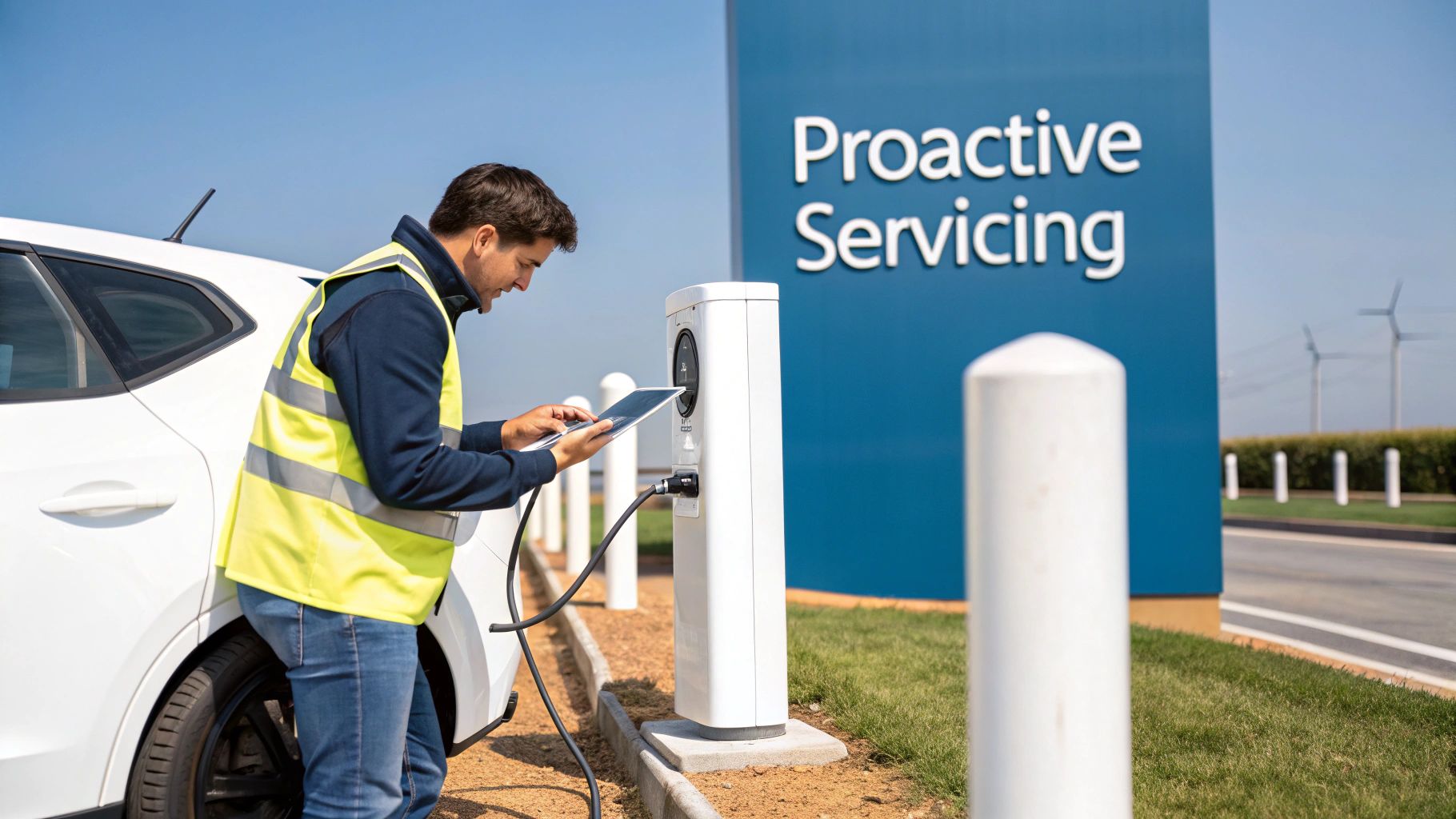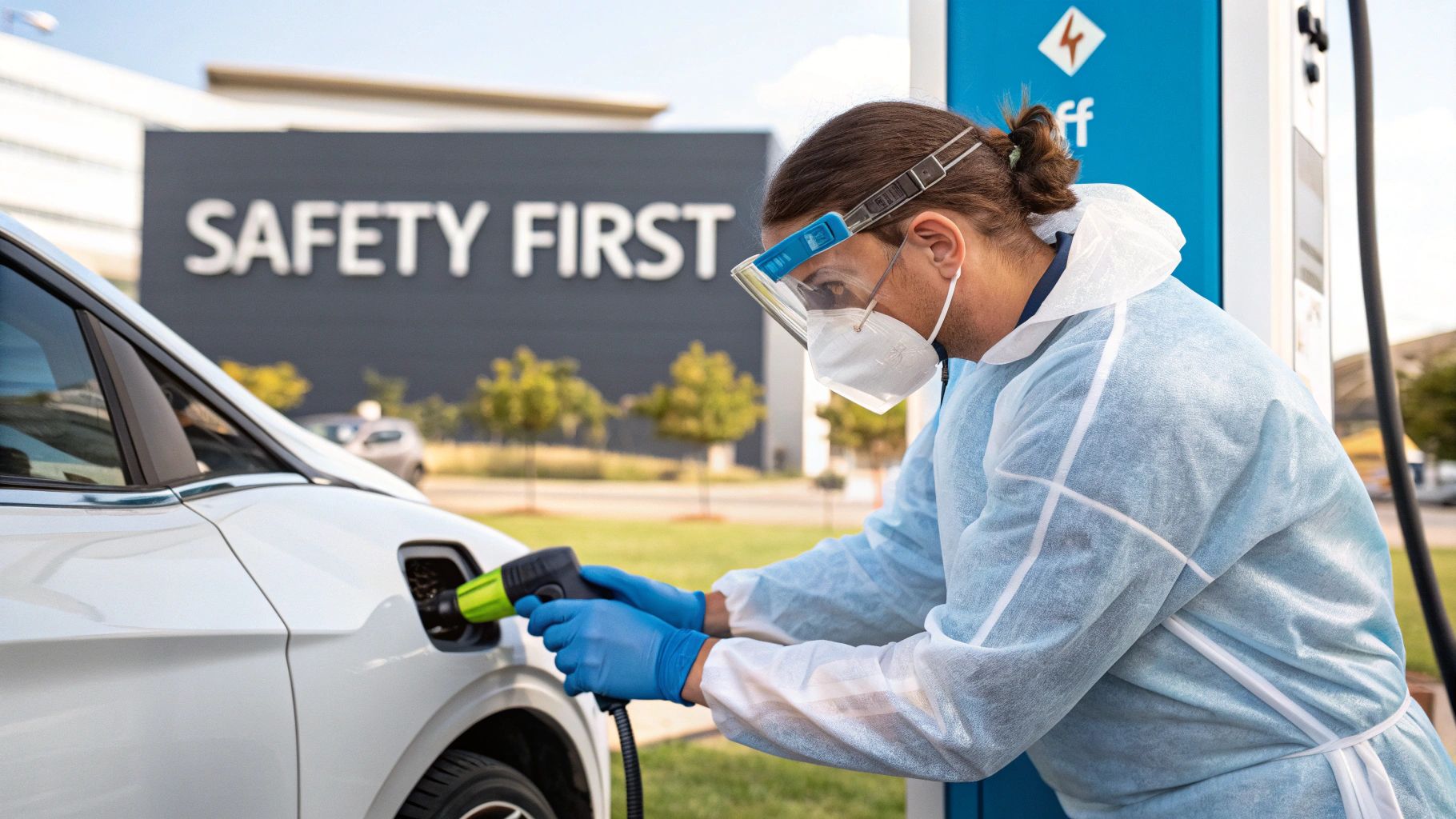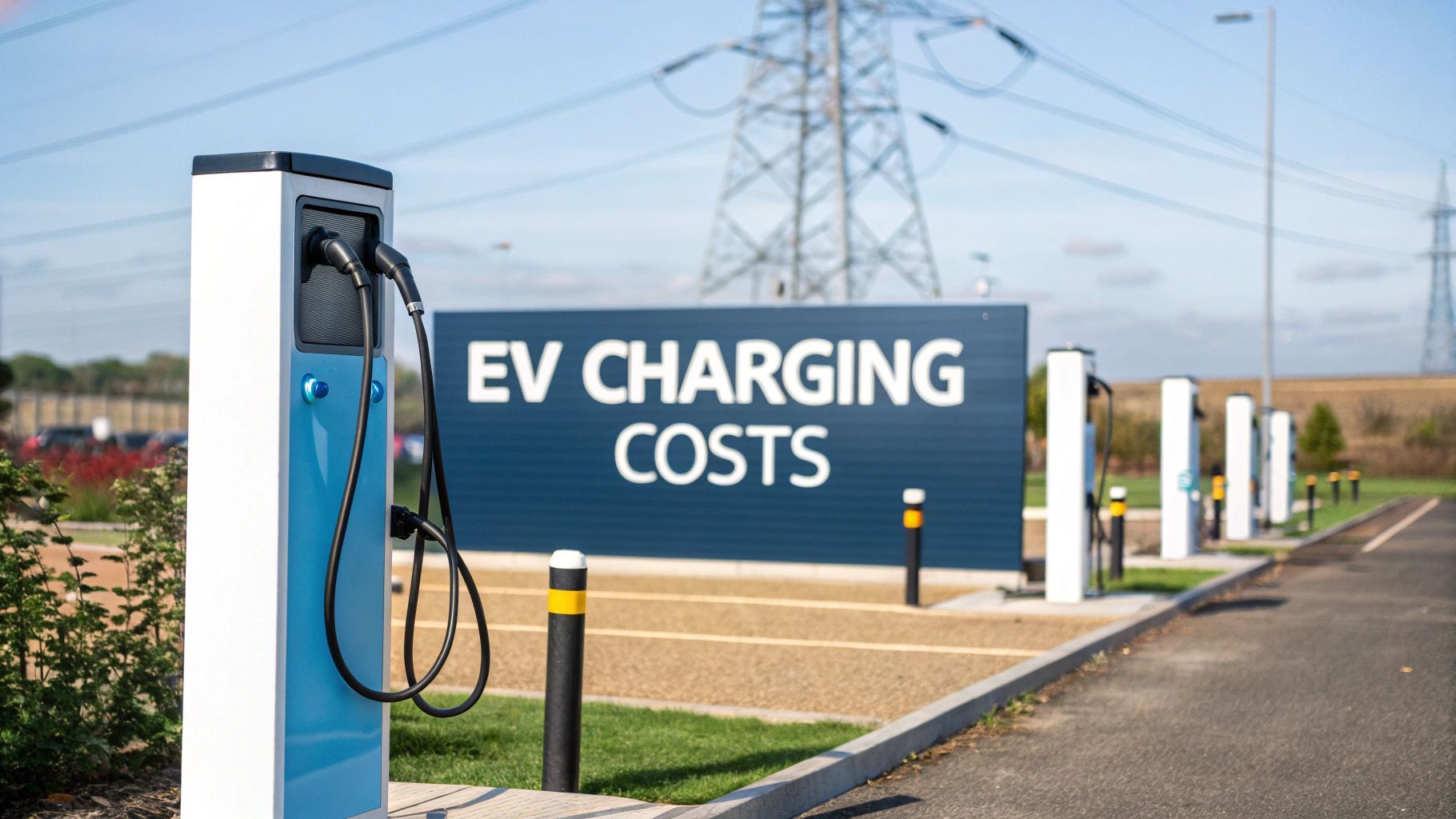UK EV Charger Servicing: A Complete Guide
EV charger servicing is not just about fixing things when they break. It is the routine inspection, testing and upkeep of charging equipment to guarantee safety, reliability and peak performance. Think of it as a crucial health check for your network, essential for keeping drivers happy and your infrastructure in top shape as it grows.
Why Proactive EV Charger Servicing Matters

The UK’s EV infrastructure is expanding at an incredible pace, which is fantastic news but with this growth comes a massive challenge: keeping a vast, sprawling network dependable. This is where proper EV charger servicing shifts from a simple "fix-it" job to a core part of your asset management strategy—one that has a direct impact on your bottom line and reputation.
Imagine a single faulty charger on a major route during a bank holiday weekend. The frustration for drivers is immense, quickly leading to scathing online reviews and a serious knock to their trust in your brand. That kind of reputational damage often costs far more to fix than the charger itself. Beyond keeping customers happy, neglect leads to very real revenue loss from downtime and more critically, can create serious safety hazards if electrical components are not inspected regularly.
The Bigger Picture: Energy Integration
Today's charging infrastructure is often much more than a simple plug in the wall. Many sites now integrate sophisticated systems to work around power limitations and boost their green credentials. For these advanced setups, proactive servicing is not just a good idea; it is absolutely vital.
- Constrained Grid Connections: Regular checks ensure chargers operate efficiently without tripping local power supplies, helping you avoid disruptive and expensive outages.
- Combined On-site Renewables and Grid-Scale Batteries: For sites hooked up to solar arrays or grid-scale batteries, servicing confirms that the entire energy ecosystem is working in harmony—from the point of generation and storage right through to the vehicle.
- Distributed Energy: Servicing helps maintain the delicate balance in these complex systems, ensuring chargers are communicating properly with other assets to optimise energy flow and keep costs down.
Neglecting servicing is not just about risking a broken charger; it is about risking the integrity of your entire energy infrastructure. A proactive maintenance schedule is the foundation of a reliable, safe and profitable network.
The scale of this challenge is growing every single day. The UK's public EV charging network is expanding rapidly, highlighting the urgent need for consistent, high-quality servicing to keep the network dependable for everyone.
Ultimately, understanding the true cost of poor charging infrastructure makes it clear why prioritising maintenance is a non-negotiable part of running a successful network.
Your Practical Checklist for Routine Charger Maintenance
A systematic approach is the only way to guarantee a reliable EV charging network. Forget reactive repairs—a solid preventative checklist is about catching the small issues before they spiral into downtime or worse, safety problems. It is this hands-on process that ensures your charging assets have a long, productive life.
Of course, not all chargers are created equal. You have to tailor the intensity of these checks to the charger's environment. A rapid EV charging station at a busy motorway service area gets a hammering compared to a 7kW unit tucked away on a quiet residential street. The former needs a much more rigorous and frequent servicing schedule to handle the constant use and exposure to the elements.
Physical and Visual Inspections
The first thing any technician should do on a service visit is a thorough physical inspection. This is not just a quick glance; it is a detailed examination of the charger from top to bottom, inside and out. Even a small crack in the casing can compromise its weatherproofing, letting in water—a notorious cause of failure.
Technicians really need to zero in on a few key areas:
- Casings and Enclosures: Look for any cracks, dents or obvious signs of vandalism. Are all the seals intact? Do the locking mechanisms still work properly?
- Cables and Connectors: Examine the charging cables for any fraying, cuts or exposed wiring. The connectors themselves should be clean and free of debris, engaging securely with a vehicle’s charge port. Bent pins or a loose fit will inevitably lead to communication errors and poor connections.
- Signage and Lighting: Check that all user instructions are still legible and that any built-in lighting is working. This is vital for user safety and accessibility, especially after dark.
Critical Electrical Safety Tests
Once the physical check is done, the electrical safety tests are non-negotiable. These diagnostics are what verify that the charger’s protective systems are working as they should, protecting both users and the grid. Skipping these steps is just not an option.
The essential tests include:
- RCD Functionality: The Residual Current Device (RCD) is a critical safety component that cuts the power if a fault is detected, preventing electric shock. Technicians must perform a trip test to confirm it operates within the specified time limits.
- Earthing Verification: A solid earth connection is fundamental to electrical safety. The checks must confirm the integrity of the earthing arrangement to make sure it can safely handle any fault currents. This is especially important for chargers linked into more complex systems with combined on-site renewables or grid-scale batteries .
A charger might look like it’s working perfectly but could be hiding a latent safety fault. Regular RCD and earthing tests are the only way to be certain that the unit will protect users when it really matters. This is a cornerstone of responsible EV charger servicing .
Connectivity and Software Health
In today's connected networks, the software is just as important as the hardware. If a charger cannot communicate with its back-office system, it is effectively offline, even if it is electrically sound.
An engineer’s checklist must include verifying the charger's connectivity, whether that is a mobile signal or a wired Ethernet connection. This means checking signal strength and diagnosing any data transmission errors. At the same time, they need to make sure the charger is running the latest firmware. Manufacturers are constantly releasing updates to improve performance, patch security holes and fix bugs, which makes proactive software management essential for a healthy network.
EV Charger Servicing Schedule by Type and Usage
To make things easier, it is useful to have a clear schedule based on the charger's role. A one-size-fits-all approach just does not work; high-traffic public chargers need more attention than private, low-use units. This table offers a practical starting point for planning your maintenance cycles.
| Charger Type | Typical Location | Recommended Service Frequency | Key Checks |
|---|---|---|---|
| AC (7-22kW) | Private Home / Workplace (Low Use) | Every 24-36 months | Basic safety tests, visual inspection, connector check. |
| AC (7-22kW) | Public Car Park / Retail (Medium Use) | Every 12 months | Full safety tests, physical inspection, software check, connector wear. |
| DC Rapid (50kW+) | Motorway Services / Fleet Depot (High Use) | Every 6-12 months | Full electrical and safety tests, deep clean of internals, filter checks. |
| DC Ultra-Rapid (150kW+) | Dedicated Charging Hub (Very High Use) | Every 6 months | As above, plus thermal imaging, cooling system checks, power module tests. |
Ultimately, this schedule acts as a baseline. For sites in harsh environments—think coastal locations with salt spray or industrial areas with a lot of dust—you may need to shorten these intervals to stay ahead of potential problems. Consistent, scheduled servicing is always more cost-effective than dealing with emergency call-outs.
Diagnosing High-Power and Rapid Chargers
Checking a simple 7kW AC post is one thing but diagnosing issues with high-power DC rapid and ultra-rapid chargers is another world entirely. These are complex power systems, often tangled up with combined on-site renewables or grid-scale batteries just to manage the huge demand from a constrained grid connection . Proper EV charger servicing at this level demands specialist tools and a much deeper understanding of the whole energy ecosystem.
Your standard electrical tests are really just the starting point. Technicians working on these advanced units have to get into the weeds of power quality analysis, load balancing diagnostics and even the health of integrated liquid cooling systems. It is a job that blends traditional electrical engineering with modern IT and thermal management.
The process below gives a simplified look at the key stages involved in keeping these advanced charging units running smoothly.

As you can see, it’s a constant cycle: inspect the hardware, test its performance and update the software. This loop is what keeps the unit safe, efficient and secure.
Advanced Diagnostic Techniques
One of the best tools we have for finding faults before they happen is thermal imaging. Long before a power module, contactor or connection fails catastrophically, it often starts to overheat. A thermal camera can instantly pick up on these hotspots, letting a technician replace a dodgy component well before it causes any downtime. This is absolutely critical for chargers that are in heavy, continuous use.
Power quality analysis is another key area. Chargers hooked up to a weak or "noisy" grid supply can suffer from all sorts of performance issues or even premature component failure. Using an analyser, we can spot problems like voltage sags, harmonic distortion or transients that help diagnose those intermittent faults that are otherwise impossible to trace.
Diagnosing Integrated Systems
The diagnostic challenge really multiplies when you combine rapid EV charging with EV charging and batteries or solar arrays. Suddenly, the problem might not even be with the charger itself but with the flow of energy from the battery or the inverter connected to the renewables.
Troubleshooting these integrated systems means getting hands-on with a few key checks:
- Load Balancing: When multiple chargers share one supply, especially if it’s buffered by a battery, they have to balance the load correctly. A technician needs to verify that the control system is distributing power intelligently and not overloading the connection.
- Battery System Communication: The charger and the battery storage unit need to be in constant communication. We use diagnostic software to check for any communication dropouts or data errors that could stop the battery from discharging properly to support a charging session.
- Cooling System Health: Many ultra-rapid chargers are liquid-cooled to handle the immense heat they generate. A service must include checking coolant levels, inspecting for leaks and making sure the pumps are working as they should. A failing cooling system will quickly cause the charger to slash its power output or just shut down completely.
You really cannot overstate the complexity of these systems. A fault that looks like it’s coming from the charger could easily originate in the grid connection, the on-site battery or even the software managing all the distributed energy assets.
The UK's charging network is growing at an incredible pace, and this growth makes expert diagnostics more critical than ever to keep the network reliable for every EV driver. Given their technical complexity and the stress of frequent use, fast chargers (anything above 50kW) demand the most diligent and specialised servicing to prevent downtime. To get a better handle on the specifics, check out our guide to UK DC fast charging.
Essential Safety Protocols for Servicing Technicians

The absolute foundation of all electrical safety is ensuring a unit is completely de-energised before any work begins. This is so much more than just flicking a switch; it requires a formal lock-out/tag-out (LOTO) procedure. This system is designed to make it physically impossible for a circuit to be accidentally re-energised while someone is working on it.
De-energisation and Verification
The LOTO process is the non-negotiable first step. It involves physically locking the isolator switch in the "off" position and attaching a tag that clearly states who is working on the equipment. Cutting corners here can have severe, often fatal, consequences.
Once locked out, the next critical phase is proving the circuit is dead. Technicians must use a calibrated voltage tester to verify there is zero voltage present at the charger terminals. This "test before you touch" principle is a fundamental rule that protects against equipment failure or simple human error.
A common mistake is someone assuming that because a charger’s screen is off, the unit is dead. High-power systems, especially those connected to grid-scale batteries , can still hold a dangerous residual charge or have multiple power feeds that must be individually isolated and verified.
Personal Protective Equipment (PPE)
Having the correct Personal Protective Equipment (PPE) is essential. Your standard workwear simply is not sufficient for the risks involved in EV charger servicing . The specific gear required is always determined by a thorough risk assessment but it typically includes several key items.
- Insulated Gloves: Rated for the voltage of the system being worked on, these are your primary defence against electric shock.
- Arc Flash Protection: This includes specialised flame-resistant overalls, hoods and visors designed to protect you from the intense heat and pressure of an arc flash event.
- Insulated Tools: Every tool used for electrical work—from screwdrivers to spanners—must be fully insulated and rated for high-voltage use.
Beyond these general hazards, technicians must also adhere to strict Electrical Safety Protocols to ensure safe handling of all high-voltage components. For a deeper dive into the components that make up these systems, our guide to Electric Vehicle Supply Equipment offers a detailed breakdown.
Ultimately, adhering to these safety standards is not just about compliance; it is about creating a safe working environment that protects everyone on site.
Managing an Effective Servicing Programme
Technical skill on its own will not guarantee a reliable network. The real key to successful EV charger servicing is robust operational management. Building an efficient servicing programme that can scale involves far more than just dispatching technicians; it demands a smart strategy that pulls together the right technology, sharp logistics and meticulous record-keeping.
A cornerstone of this strategy is building a tiered response system. An out-of-service rapid charger on a major A-road is a critical failure that needs immediate attention. On the other hand, a single faulty unit in a large workplace car park can probably wait a bit. By categorising faults based on charger type, location and typical usage, you can funnel your resources where they will make the biggest impact, keeping network uptime and driver satisfaction as high as possible.
Leveraging Technology for Proactive Maintenance
Modern back-office software has become absolutely essential for managing any widespread charging network. These platforms give operations teams the power of remote diagnostics, letting them spot communication errors, payment terminal faults or even internal component warnings long before a driver ever reports a problem.
This proactive approach completely changes the game. It shifts EV charger servicing from a reactive chore into a preventative measure. Often, a remote reset or a quick software patch can resolve the issue without anyone ever needing to visit the site.
When a physical repair is unavoidable, this technology makes sure the technician arrives ready to work. The system can pinpoint the exact fault, so the engineer turns up with the right spare parts and tools for the job. This dramatically improves first-time fix rates.
Smart inventory management is the logistical backbone of any servicing programme. Knowing exactly what spare parts you have and where they are located prevents costly delays and ensures critical chargers are brought back online as quickly as possible.
Scaling Operations and Ensuring Compliance
As your network grows, so does the complexity of managing it. Government and industry data show that the UK’s EV charger servicing market is dealing with a rapidly expanding and incredibly diverse infrastructure base.
Official statistics show that tens of thousands of devices need consistent servicing, calibration and repair to stay reliable. These activities are vital for meeting regulatory safety and performance standards. You can read more about the UK's charging infrastructure statistics on GOV.UK.
To handle this scale, detailed record-keeping is non-negotiable. Every single service visit, repair and component replacement must be logged. This data is not just for ticking compliance boxes; it provides priceless insights into the real-world performance of different charger models. This helps you make smarter procurement decisions down the line and even predict component lifecycles.
Beyond the specifics of EV chargers, a solid grasp of the general principles for heavy and light equipment servicing can offer valuable frameworks for managing an effective programme.
Ultimately, comprehensive technician training underpins everything. You need to ensure your engineers are competent with a huge range of hardware, from standard AC posts to the most complex rapid EV charging systems integrated with grid-scale batteries .
Any Questions About EV Charger Servicing?
As EV charging networks get bigger and more complex, it is only natural for site owners to have questions about looking after their hardware. Getting your head around the details of an EV charger servicing agreement is the key to making smart decisions and keeping your infrastructure healthy for the long run.
Let’s tackle some of the most common queries we hear about servicing schedules, what should be in a contract and how long key parts are likely to last. This should help you map out your maintenance strategy.
How Often Do My EV Chargers Need Servicing?
The honest answer? It really depends on the charger’s type and how much it is being used. A private 7kW workplace charger that sees occasional use might only need a full service every couple of years. On the other hand, a high-traffic rapid EV charging unit at a motorway service station will need a thorough inspection at least every six months.
You need to weigh up a few factors:
- Usage Levels: The more a charger is used, the faster components like cables, connectors and cooling systems will wear out. It is simple wear and tear.
- Environment: Is your charger in a harsh environment? Coastal areas with salt spray or dusty industrial sites are tough on equipment and demand more frequent checks.
- Technology: More complex units, especially those hooked up to grid-scale batteries or combined on-site renewables , have more things that can potentially go wrong and need a closer eye kept on them.
What Should a Good Service Agreement Include?
A decent servicing contract is much more than a simple break-fix arrangement. Think of it as a proactive partnership focused on maximising your uptime and guaranteeing safety.
A solid agreement will always cover these bases:
- Scheduled Preventative Maintenance: This means routine electrical safety tests (like RCD checks), physical inspections, cleaning and essential firmware updates.
- Call-out Response Times: A tiered system is pretty standard here, ensuring a much faster response for critical failures at your most important, high-revenue sites.
- Remote Diagnostics: The ability to monitor chargers from a distance—and often fix issues without a site visit—is a massive advantage for any modern network.
- Parts and Labour: You need clarity on what is covered. This ensures you are not hit with hidden costs when common components inevitably fail.
When you are looking over a service agreement, check that the focus is on preventative action, not just reactive repairs. The goal is always to spot and fix potential problems before they cause downtime. Trust me, it is far more cost-effective in the long run.
At the end of the day, parts like contactors, cables and cooling fans all have different lifespans depending on how they are used. Regular, professional servicing is simply the best way to get more life out of them and maximise the return on your investment.
At ZPN Energy , we provide comprehensive servicing and management for all types of EV charging infrastructure, from single units to complex distributed energy networks. Learn more about our integrated solutions at https://www.zpnenergy.com.








